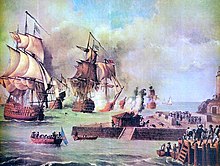
The War of Jenkins' Ear was a conflict lasting from 1739 to 1748 between Britain and Spain. The majority of the fighting took place in New Granada and the Caribbean Sea, with major operations largely ended by 1742. It was related to the 1740 to 1748 War of the Austrian Succession. The name was coined in 1858 by British historian Thomas Carlyle, and refers to Robert Jenkins, captain of the British brig Rebecca, whose ear was allegedly severed by Spanish coast guards while searching his ship for contraband in April 1731.
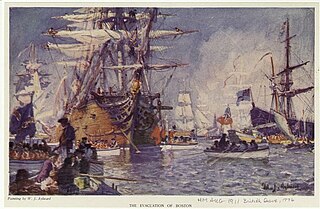
The siege of Boston was the opening phase of the American Revolutionary War. In the siege, American patriot militia led by newly-installed Continental Army commander George Washington prevented the British Army, which was garrisoned in Boston, from moving by land. Both sides faced resource, supply, and personnel challenges during the siege. British resupply and reinforcement was limited to sea access, which was impeded by American vessels. The British ultimately abandoned Boston after eleven months, moving their troops and equipment north, to Nova Scotia.

Admiral Edward Vernon was a Royal Navy officer and politician. He had a long and distinguished career, rising to the rank of admiral after 46 years service. As a vice admiral during the War of Jenkins' Ear, in 1739 he was responsible for the capture of Portobelo, Panama, seen as expunging the failure of Admiral Hosier there in a previous conflict. However, his amphibious operation against the Spanish port of Cartagena de Indias was a disastrous defeat. Vernon also served as a Member of Parliament (MP) on three occasions and was outspoken on naval matters in Parliament, making him a controversial figure.

The Castillo de los Tres Reyes del Morro(English: Castle of the Three Kings of Morro), also known as Castillo del Morro(Morro Castle), is a fortress guarding the entrance to the Havana harbor. The design is by the Italian engineer Battista Antonelli (1547–1616). Originally under the control of Spain, the fortress was captured by the British in 1762, returned to Spain under the Treaty of Paris (1763) a year later. The Morro Castle was the main defense in the Havana harbor until La Cabaña was completed in 1774.

Sir William Gooch, 1st Baronet was a British Army officer and colonial administrator who served as the governor of Virginia from 1727 to 1749. Technically, Gooch only held the title of Royal Lieutenant Governor, but the nominal governors, Lord Orkney and Lord Albemarle, were in England and did not exercise much authority. Gooch's tenure as governor was characterized by his unusual political effectiveness.
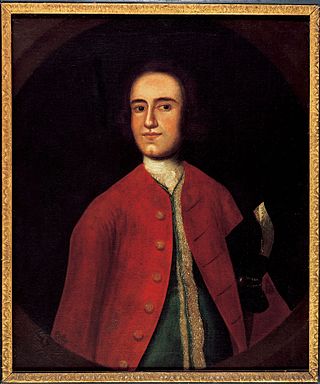
Lawrence Washington was an American soldier, planter, politician, and prominent landowner in colonial Virginia. As a founding member of the Ohio Company of Virginia, and a member of the colonial legislature representing Fairfax County, he also founded the town of Alexandria, Virginia on the banks of the Potomac River in 1749.
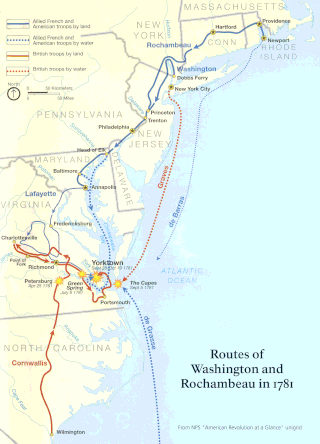
The Yorktown campaign, also known as the Virginia campaign, was a series of military maneuvers and battles during the American Revolutionary War that culminated in the siege of Yorktown in October 1781. The result of the campaign was the surrender of the British Army force of General Charles Earl Cornwallis, an event that led directly to the beginning of serious peace negotiations and the eventual end of the war. The campaign was marked by disagreements, indecision, and miscommunication on the part of British leaders, and by a remarkable set of cooperative decisions, at times in violation of orders, by the French and Americans.

Admiral Blas de Lezo y Olavarrieta was a Spanish navy officer best remembered for the Battle of Cartagena de Indias (1741) in the Viceroyalty of New Granada, where Spanish imperial forces under his command decisively defeated a large British invasion fleet under Admiral Edward Vernon.

Sebastián de Eslava y Lazaga was a Spanish general and colonial official. From April 24, 1740 to November 6, 1749 he was viceroy of the newly reestablished Viceroyalty of New Granada. He was governing the viceregal at the time of the defeat of British Admiral Edward Vernon at the Battle of Cartagena de Indias. After his death he was named marqués de la Real Defensa de Cartagena de Indias.

The Battle of Cartagena de Indias took place during the 1739 to 1748 War of Jenkins' Ear between Spain and Great Britain. The result of long-standing commercial tensions, the war was primarily fought in the Caribbean; the British tried to capture key Spanish ports in the region, including Porto Bello and Chagres in Panama, Havana, and Cartagena de Indias in present-day Colombia.

Vice-Admiral Sir Joshua Rowley, 1st Baronet was a Royal Navy officer who was the fourth son of Admiral Sir William Rowley. Sir Joshua was from an ancient English family, originating in Staffordshire (England) and was born on 1 May 1734. Rowley served with distinction in a number of battles throughout his career and was highly praised by his contemporaries. Unfortunately whilst his career was often active he did not have the opportunity to command any significant engagements and always followed rather than led. His achievements have therefore been eclipsed by his contemporaries such as Keppel, Hawke, Howe and Rodney. Rowley however remains one of the stalwart commanders of the wooden walls that kept Britain safe for so long.

The Battle of Sullivan's Island or the Battle of Fort Sullivan was fought on June 28, 1776, during the American Revolutionary War. It took place near Charleston, South Carolina, during the first British attempt to capture the city from American forces. It is also sometimes referred to as the first siege of Charleston, owing to a more successful British siege in 1780.

The siege of Havana was a successful British siege against Spanish-ruled Havana that lasted from March to August 1762, as part of the Seven Years' War. After Spain abandoned its former policy of neutrality by signing the family compact with France, resulting in a British declaration of war on Spain in January 1762, the British government decided to mount an attack on the important Spanish fortress and naval base of Havana, with the intention of weakening the Spanish presence in the Caribbean and improving the security of its own North American colonies. A strong British naval force consisting of squadrons from Britain and the West Indies, and the military force of British and American troops it convoyed, were able to approach Havana from a direction that neither the Spanish governor nor the Admiral expected and were able to trap the Spanish fleet in the Havana harbour and land its troops with relatively little resistance.
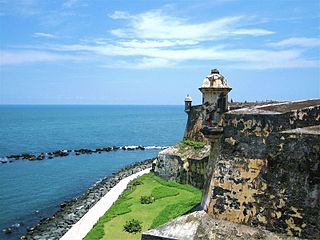
The invasion of Cuba took place between 4–5 August and 9 December 1741 during the War of Jenkins' Ear. A combined army and naval force under the command of Admiral Edward Vernon and Major-General Thomas Wentworth arrived off Cuba and fortified positions around their landing site at Cumberland Bay. Despite facing no serious opposition, neither commander felt prepared to advance on the Spanish settlement at Santiago de Cuba. Harassed by Spanish raids and with a mounting sick list, the British finally evacuated the island after several months of inactivity.
Tryon's Raid occurred in July 1779, during the American Revolutionary War, in which 2700 men, led by British Major General William Tryon, raided the Connecticut ports of New Haven, Fairfield, and Norwalk. They destroyed military and public stores, supply houses, and ships as well as private homes, churches, and other public buildings. The raids were ineffectually resisted by militia forces.
James Innes was an American military commander and political figure in the Province of North Carolina who led troops both at home and abroad in the service of the Kingdom of Great Britain. Innes was given command of a company of North Carolina's provincial soldiers during the War of Jenkins' Ear, and served as Commander-in-Chief of all colonial soldiers in the Ohio River Valley in 1754 during the French and Indian War. After resigning his commission in 1756, Innes retired to his home on the Cape Fear River. A bequest made by Innes upon his death lead to the establishment of Innes Academy in Wilmington, North Carolina.

The British Army during the American Revolutionary War served for eight years in the American Revolutionary War, which was fought throughout North America, the Caribbean, and elsewhere from April 19, 1775 to September 3, 1783. The war formally commenced at the Battles of Lexington and Concord in present-day Massachusetts. Two months later, in June 1775, the Second Continental Congress, gathered in the revolutionary capital of Philadelphia, appointed George Washington to organize patriot militias into the Continental Army and lead them in a war against the British Army. The following year, in July 1776, the Second Continental Congress, representing the Thirteen Colonies, declared themselves free and independent from colonial governance.

Provincial troops were military units raised by colonial governors and legislatures in British North America for extended operations during the French and Indian Wars. The provincial troops differed from the militia, in that they were a full-time military organization conducting extended operations. They differed from the regular British Army in that they were recruited only for one campaign season at the time. These forces were often recruited through a quota system applied to the militia. Officers were appointed by the provincial governments. During the eighteenth century militia service was increasingly seen as a prerogative of the social and economic well-established, while provincial troops came to be recruited from different and less deep-rooted members of the community.

British Army Independent Companies in South Carolina formed a major component of the Province of South Carolina's military security. Regular independent companies were first established in British North America in 1664. The first Independent Company in South Carolina was organized in 1721. With the raising of Oglethorpe's Regiment in 1737 it was disbanded. In 1746 three understrength independent companies were sent to South Carolina, but they were disbanded two years later. When Oglethorpe's Regiment was disbanded in 1748, three new independent companies were raised in South Carolina, partly recruited with soldiers from the disbanded regiment. These three companies participated in the French and Indian War and the Cherokee War, participating in the Battle of Fort Necessity, the Braddock Expedition, the battle of the Monongahela, and the siege of Fort Loudoun. They were disbanded in 1763, with the rest of the British army independent companies in North America.

Justly Watson was an English army officer and military engineer in the British Army, rising to the rank of lieutenant-colonel in the Royal Engineers. He served beside his father Jonas Watson, an officer in the Royal Artillery, at the Siege of Gibraltar in 1727. He joined the Royal Engineers in 1732, served at Carthagena, and in the futile attempt on Cuba, in 1741, and the attack on Panama in 1742. He was stationed at Jamaica from 1742 to 1744, surveyed Darien and Florida in 1743, and served in the descent on Brittany in 1746. He was appointed chief engineer in the Medway Division in 1748, and reported on the West African stations from 1755 to 1756. He was stationed in Nova Scotia and Newfoundland in 1757, and died there, probably from coffee poisoned by a black female domestic.

